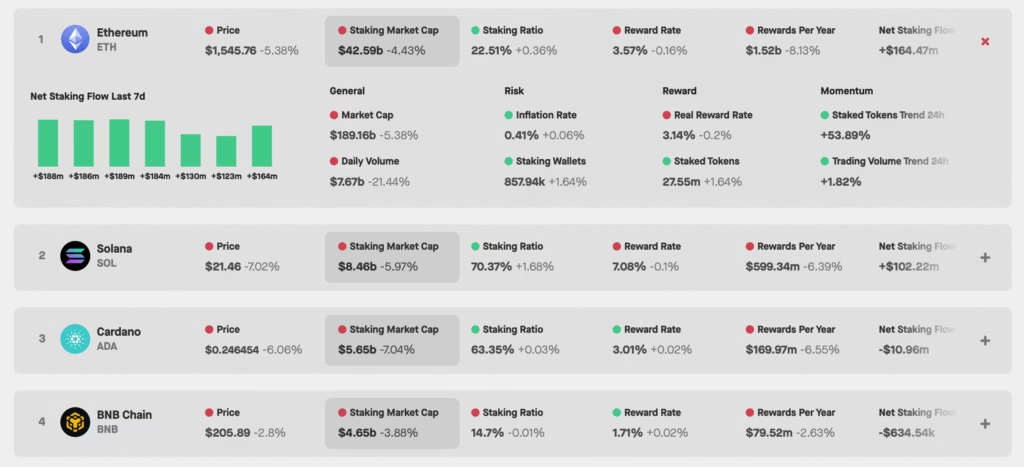
- Cryptocurrency
- By Cubex
Crypto Staking 101: How to Stake Crypto and Earn Rewards
Crypto staking is a process used by Proof of Stake (PoS) blockchain networks to help validate and secure transactions. It involves locking up your cryptocurrency in a smart contract, allowing you to earn potential rewards in return for supporting the network. Your staked assets are typically held by a third-party custodian, such as a crypto exchange, wallet provider, or a dedicated staking platform operating on a PoS blockchain.
To fully understand crypto staking, it’s important to first grasp the Proof of Stake (PoS) consensus mechanism used by many blockchains.
Proof of Stake is a method that helps blockchains achieve decentralized consensus without relying on energy-intensive mining. Instead of miners, validators are selected to confirm transactions, create new blocks, and secure the network. Validators are chosen based on the amount of cryptocurrency they “stake” or lock up as collateral.
In return for supporting the network, validators receive staking rewards—typically in the form of newly minted crypto tokens.
How Crypto Staking Works: A Simple Breakdown
When you stake your crypto, you’re locking it into a smart contract to help secure and operate a Proof of Stake (PoS) blockchain network. In exchange, you earn staking rewards, typically a share of newly minted coins or transaction fees.
While staking mechanics can vary by blockchain, the general process looks like this:
1. Cryptocurrency Ownership
To participate in staking, you must own the native token of a PoS blockchain, such as ETH for Ethereum or SOL for Solana.
2. Staking Your Tokens
You commit your tokens by locking them in a crypto wallet or via a staking platform. Some protocols allow you to stake directly from your wallet, while others require you to use a validator or delegate your stake.
⚠️ Note: Once staked, your tokens become temporarily inaccessible for trading or withdrawals. Unstaking may take hours, days, or even weeks depending on the network’s rules.
3. Validation and Rewards
Your staked tokens help validate transactions and secure the network. In return, you receive staking rewards—which may include newly created tokens or a portion of transaction fees. Rewards are often distributed regularly (e.g., daily or weekly).
4. Governance Participation
Many PoS networks give stakers voting rights, allowing them to help shape future upgrades and decisions related to the protocol.
5. Network-Specific Rules
Every blockchain has different staking requirements. Some require a minimum stake amount, while others have variable lock-up periods and reward structures.
How to Start Staking Crypto in 3 Simple Steps
Getting started with crypto staking is easier than you might think. Here’s a quick step-by-step guide to help you begin earning passive income from your digital assets.
Step 1: Pick a Proof of Stake (PoS) Cryptocurrency
Not every cryptocurrency supports staking, so the first step is choosing a coin built on a PoS or delegated PoS blockchain.
Selecting the right token can depend on several factors—like reward rates, lock-up periods, and network stability. To help you decide, we’ve compiled a list of popular staking cryptocurrencies that are beginner-friendly and widely supported.
- Ethereum (ETH): The second-largest cryptocurrency by market capitalization, known for its smart contract functionality.
- Solana (SOL): A high-performance blockchain known for its speed and scalability, supporting decentralized applications (dApps).
- Polkadot (DOT): A multi-chain network that enables interoperability and communication between different blockchains.
- Avalanche (AVAX): A platform designed for creating custom blockchain networks and decentralized applications.
- Cosmos (ATOM): A blockchain focused on interoperability, connecting various blockchains to create a more inclusive web3 ecosystem.
Step 2: Transfer Your Crypto to a Staking-Supported Wallet or Exchange
To stake your crypto, you’ll need to use a wallet or exchange that supports staking. Since staking plays a major role in decentralized finance (DeFi)—with billions of dollars in total value locked—most major centralized exchanges (CEXs) and crypto wallets now offer built-in staking options.
Before you begin, confirm that your chosen platform supports staking for the specific cryptocurrency you want to stake. If your crypto is currently stored in an external wallet that doesn’t offer staking, you’ll need to transfer your funds to a supported wallet or exchange to proceed.
As always, it’s best to research all available options and choose a secure and reliable wallet that’s right for you.
Step 3: Join a Staking Pool
If you’re using a non-custodial wallet and don’t want to set up your own validator node, joining a staking pool is a simple and effective option.
Staking pools allow multiple crypto holders to combine their tokens and stake them collectively, increasing their chances of earning rewards. This method removes the need for advanced technical knowledge or large amounts of capital—making staking more accessible to everyday users.
Here’s how to get started with a staking pool:
- Research and choose a reputable staking pool.
- Connect your crypto wallet to the pool.
- Stake your tokens through the pool’s interface.
- Earn rewards based on your contribution share.
Staking pools typically charge a small fee for their service, and distribute rewards proportionally among participants. Much like mining pools, they help lower the barrier to entry for those who want to earn staking rewards without running their own infrastructure.
As staking continues to grow in popularity, staking pools are becoming a go-to solution for crypto holders who want to earn passive income in a hassle-free way.
Benefits of Staking Cryptocurrency
Staking has become a popular choice in the Web3 ecosystem—and for good reason. Here are some of the key benefits of staking your crypto:
1. Earn Passive Income: By staking your tokens, you can earn regular staking rewards, often paid out in the same cryptocurrency. It’s one of the easiest ways to put your crypto to work and generate passive income.
2. Help Secure the Network: Staking contributes to the security and stability of Proof of Stake (PoS) blockchains. By locking up your tokens, you’re supporting transaction validation and helping keep the network safe from attacks.
3.Promote Greater Decentralization: Participating in staking helps decentralize control of the network by distributing validation responsibilities across more users, rather than concentrating them in the hands of a few.
4. Eco-Friendly Alternative to Mining: Unlike Proof of Work (PoW) mining, staking doesn’t require energy-intensive hardware. This makes it a more environmentally sustainable way to support blockchain technology.
How are staking rewards calculated?
Staking rewards are typically calculated based on the following factors:
- Amount: The more cryptocurrency you stake, the more you maximize rewards.
- Duration: Some networks reward longer-term stakes with higher returns.
- Network rules: Each PoS network may have unique rules and parameters for reward distribution.
(Helpful tools like the Staking Rewards Explorer can be used to estimate your potential staking returns based on factors like token amount, lock-up period, and network APY.- image source.)
Conclusion
By staking your crypto, you’re essentially offering it as collateral to help maintain the network’s integrity. In return, you can earn passive income—making staking one of the most popular ways to put idle crypto to work.
Related: How to Buy Gift Cards With Crypto: A Quick & Easy Guide

12 Most Popular Types of Crypto Coins



